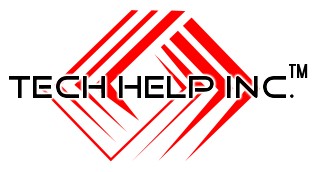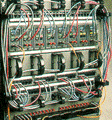

| | | | | | | |||||||
| | | | | | ||||||
| | | | ||||
fiberoptic cable (FDDI {Fiber Distributed Data Interface}).
Twisted-Pair Cable - consists of two insulated strands of copper wire twisted around each other to form a pair. One or more pairs are used in
a twisted-pair cable. The purpose of twisting the wires is to eliminate electrical interference from other wires and outside sources such as
motors. Twisting the wires cancel any electrical noise from the adjacent pair. The more twist per linear foot, the greater the effect. Twisted-pair
comes in two types: STP (shielded twisted pair) and UTP (Unshielded Twisted Pair). The STP (Shielded Twisted Pair) has a foil or wire braid
wrapped around the individual wires of the pairs and UTP (Unshielded Twisted Pair) does not. The STP cable uses a woven-copper braided
jacket, which is a higher quality, more protective jacket than UTP. Of the two types, UTP is more common. UTP cables can be divided further
into six categories:
Category 1 - traditional telephone cable that uses the RJ11 head and plugs in the phone jack outlet in your home. It can carry voice but not
data by (itself). This cable is a 4 wire/2 pair setup.
Category 2- certified UTP for data transmission of up to 4 megabits per second (Mbps). It has four twisted pairs.
Category 3 - certified UTP for data transmission of up to 10 Mbps. It has four twisted pairs.
Category 4 - certified UTP for data transmission of up to 16 Mbps. It has four twisted pairs.
Category 5 - certified for data transmission of up to 100 Mbps. It has four twisted pairs of copper wire.
Category 6 - offers transmission speed up to 155 Mbps.
Note: Category 2-6 can use the RJ45 head, because the RJ45 head can accommodate for the 8 wire/4 pair cable.
Twisted-pair cable has several advantages over other types of cables (coaxial and fiberoptic). It's readily available, easy to install, and
inexpensive. Among its disadvantages are its sensitivity to electromagnetic interference (EMI), its susceptibility to eavesdropping, its lack of
support for communication at distances of greater than 100 feet, and its requirement of a hub (multiple network connection point) if it is to be
used with more than one computer.
Coaxial Cable - is made of two conductors that share the same axis; the center is a copper wire that is insulated by a plastic coating and then
wrapped with an outer conductor (usually a wire braid). This outer conductor around the insulation serves as electrical shielding for the signal
being carried by the inner conductor. A tough insulating plastic tube outside the outer conductor provides physical and electrical protection.
At one time, coaxial cable was the most widely used network cabling. However, with improvements and the lower cost of twisted pair cables, it
has lost it popularity. Coaxial cables are found in two types: thin (ThinNet) and thick (ThickNet). ThinNet (.25 inches in diameter) is easier to
work with and carries a signal about 605 feet (185 meters) before signal strength begin to suffer. ThickNet (.38 inches in diameter) is a better
conductor and can carry a signal 1640 feet (500 meters) before signal strength begins to suffer. However the ThickNet is more difficult to work
with than the ThinNet.
Fiberoptic Cable - is made of light conducting glass or plastic fibers. Its carries data signals in the form of modulated pulses of light. The
plastic-core cables are easier to install but do not carry signals as far as the glass-core cables. Multiple fiber cores can be bundled in the
center of the protective tubing. When both material and installation cost are taken into account, fiberoptic cables can prove to be no more
expensive than twisted-pairs or coaxial cables. Unlike twisted pair cables, fiberoptic cables are immune to EMI (electromagnetic interference)
and detection outside the cable and provides a reliable and secure transmission media. Because of its very high bandwidth (the amount of
data the cable can carry) fiberoptic cables can handle thousands of times more data than twisted pairs or coaxial cables. Depending on the
fiberoptic cable (glass or plastic core), the cable length can run from .25 to 2.0 kilometers. If you need to network multiple buildings, this
should be the cable of choice.
The following table shows the common types of cables and their specifications.
Name Description Type Segment Speed
10BaseT being phased out for UTP .5 to 100 meters 10Mbps
10Base2 Ethernet ThinNet Coaxial 185 meters 10 Mbps
10Base5 ThickNet Ethernet Coaxial 500 meters 10 Mbps
100BaseT Common Twisted pair .5 to 100 meters 100 Mbps
Basic Network Protocols
A network protocol is a set of rules that govern the way computers communicate over a network. For computers using different software to
communicate, they must follow the same set of networking rules and agreements called protocols. A protocol is much like a language. Two or
more computers must communicate in the same protocol (language) or no communication will take place.
The following is a list of standard network protocols:
IPX/SPX (Internetwork Packet Exchange/Sequenced Packet Exchange) - The NetWare core protocol developed by Novell in the early
1980s.
NetBIOS/NetBEUI (Networked Basic Input/Output System/NetBIOS Enhanced User Interface) - a local area protocol developed by IBM
and refined by Microsoft; originally the native protocol for LAN Manager and Windows NT. IBM developed NetBIOS as a way to permit small
groups of computers to share files and printers efficiently. NetBIOS is the original edition; NetBEUI is an enhanced version for more powerful
network based on 32-bit systems.
TCP/IP (Transmission Control Protocol/Internet Protocol) - a set of standard protocols and services. Developed by the Department of
Defense in the early 1970s as part of an effort to link government computers. This led to the development of the Internet. Because TCP/IP is
the foundation of the Internet, as well as the most widely used networking protocol, it is a good choice for networks.
AppleTalk - a network protocol utilized by Macintosh computers.
DLC (Data Link Control) Protocol - the oldest protocol of this group, IBM developed DLC to connect token-ring based workstations (clients)
to IBM mainframe computers. Printer manufacturers have adopted the protocol to connect remote printers to network print servers.